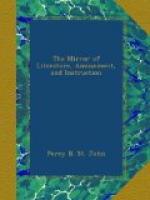Affection of Animals.
“Animals are so capable of showing gratitude and affection to those who have been kind to them, that I never see them subjected to ill treatment without feeling the utmost abhorrence of those who are inflicting it. I know many persons who, like myself, take a pleasure in seeing all the animals about them appear happy and contented. Cows will show their pleasure at seeing those who have been kind to them, by moving their ears gently, and putting out their wet noses. My old horse rests his head on the gate with great complacency when he sees me coming, expecting to receive an apple or a piece of bread. I should even be sorry to see my poultry and pigs get out of my way with any symptoms of fear.”
The Moor-hen.
One of Mr. Haydon’s new pictures is the first start in life—a mother teaching her infant to walk—it is a clever sketch, but, bearing in mind the beautiful comparison of Solomon and the lily of the valley, here is a counterpart.
“Fishing the other day in Hampton Court Park, I disturbed a moor-hen who had just hatched, and watched her anxiety and manoeuvres to draw away her young. She would go a short distance, utter a cry, return, and seemed to lead the way for her brood to follow. Having driven her away, that I might have a better opportunity of watching her young ones, she never ceased calling to them, and they made towards her, skulking amongst the rushes, till they got to the other side of the pond. They had only just left the shell, and had probably never heard the cry of their mother before.”
There is true benevolence in these remarks. How much is conveyed in the homely expression, that such a man “would not tread upon a worm:” we should learn to covet such men as friends.
The Cardinal Spider.
“There is a large breed of spiders which are found very generally in the palace of Hampton-Court. They are called there ‘cardinals,’ having I suppose been first seen in Cardinal Wolsey’s hall. They are full an inch in length, and many of them of the thickness of a finger. Their legs are about two inches long, and their body covered with a thick hair. They feed chiefly on moths as appears from the wings of that insect being found in great abundance under and amongst their webs. In running across the carpet in an evening, with the shade cast from their large bodies by the light of the lamp or candle, they have been mistaken for mice, and have occasioned no little alarm to some of the more nervous inhabitants of the palace. A doubt has even been raised whether the name of cardinal has not been given to this creature from an ancient supposition that the ghost of Wolsey haunts the place of his former glory under this shape. Be this as it may, the spider is considered as a curiosity, and Hampton-Court is the only place in which I have met with it.”
Did Wolsey, arrayed in all his glory, ever regard a spider, or think that his proud name would be coupled with so minute a member of the creation?




